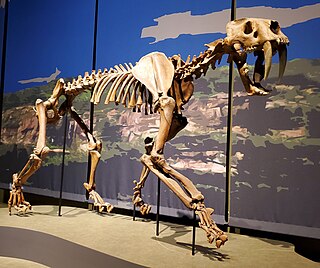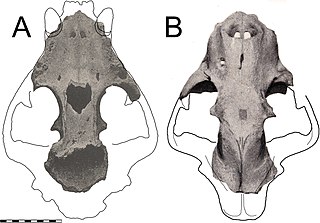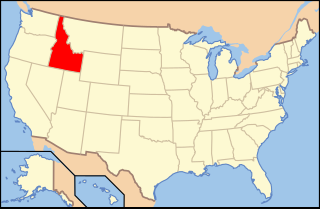
Allosaurus is an extinct genus of large carnosaurian theropod dinosaur that lived 155 to 145 million years ago during the Late Jurassic period. The name "Allosaurus" means "different lizard", alluding to its unique concave vertebrae. It is derived from the Greek words ἄλλος and σαῦρος. The first fossil remains that could definitively be ascribed to this genus were described in 1877 by famed paleontologist Othniel Charles Marsh. As one of the first well-known theropod dinosaurs, it has long attracted attention outside of paleontological circles.

Tyrannosaurus is a genus of large theropod dinosaur. The species Tyrannosaurus rex, often called T. rex or colloquially T-Rex, is one of the best represented theropods. It lived throughout what is now western North America, on what was then an island continent known as Laramidia. Tyrannosaurus had a much wider range than other tyrannosaurids. Fossils are found in a variety of rock formations dating to the Maastrichtian age of the Upper Cretaceous period, 68 to 66 million years ago. It was the last known member of the tyrannosaurids and among the last non-avian dinosaurs to exist before the Cretaceous–Paleogene extinction event.

Smilodon is a genus of felids belonging to the extinct subfamily Machairodontinae. It is one of the best known saber-toothed predators and prehistoric mammals. Although commonly known as the saber-toothed tiger, it was not closely related to the tiger or other modern cats. Smilodon lived in the Americas during the Pleistocene epoch. The genus was named in 1842 based on fossils from Brazil; the generic name means "scalpel" or "two-edged knife" combined with "tooth". Three species are recognized today: S. gracilis, S. fatalis, and S. populator. The two latter species were probably descended from S. gracilis, which itself probably evolved from Megantereon. The hundreds of specimens obtained from the La Brea Tar Pits in Los Angeles constitute the largest collection of Smilodon fossils.

Homotherium is an extinct genus of machairodontine scimitar-toothed cat that inhabited North America, South America, Eurasia, and Africa during the Pliocene and Pleistocene epochs from around 4 million to 12,000 years ago. In comparison to Smilodon, the canines of Homotherium were shorter, and it was probably adapted to running down rather than ambushing prey.

The dire wolf is an extinct canine. It is a North American prehistoric carnivore that was a competitor to the extinct Smilodon. The dire wolf lived in the Americas and eastern Asia during the Late Pleistocene and Early Holocene epochs. The species was named in 1858, four years after the first specimen had been found. Two subspecies are recognized: Aenocyon dirus guildayi and Aenocyon dirus dirus. The largest collection of its fossils has been obtained from the Rancho La Brea Tar Pits in Los Angeles.

Ankylosaurus is a genus of armored dinosaur. Its fossils have been found in geological formations dating to the very end of the Cretaceous Period, about 68–66 million years ago, in western North America, making it among the last of the non-avian dinosaurs. It was named by Barnum Brown in 1908; it is monotypic, containing only A. magniventris. The generic name means "fused" or "bent lizard", and the specific name means "great belly". A handful of specimens have been excavated to date, but a complete skeleton has not been discovered. Though other members of Ankylosauria are represented by more extensive fossil material, Ankylosaurus is often considered the archetypal member of its group, despite having some unusual features.

Machairodontinae is an extinct subfamily of carnivoran mammals of the family Felidae. They were found in Asia, Africa, North America, South America, and Europe from the Miocene to the Pleistocene, living from about 16 million until about 11,000 years ago.

Barnum Brown, commonly referred to as Mr. Bones, was an American paleontologist. Named after the circus showman P. T. Barnum, he discovered the first documented remains of Tyrannosaurus during a career that made him one of the most famous fossil hunters working from the late Victorian era into the early 20th century.

Xenosmilus is an extinct genus of homotherin machairodontine that was discovered in Florida in 2001. It has one species, Xenosmilus hodsonae.

Thylacosmilus is an extinct genus of saber-toothed metatherian mammals that inhabited South America from the Late Miocene to Pliocene epochs. Though Thylacosmilus looks similar to the "saber-toothed cats", it was not a felid, like the well-known North American Smilodon, but a sparassodont, a group closely related to marsupials, and only superficially resembled other saber-toothed mammals due to convergent evolution. A 2005 study found that the bite forces of Thylacosmilus and Smilodon were low, which indicates the killing-techniques of saber-toothed animals differed from those of extant species. Remains of Thylacosmilus have been found primarily in Catamarca, Entre Ríos, and La Pampa Provinces in northern Argentina.

Metailurus is a genus of saber-toothed cat in the family Felidae, and belonging to the tribe Metailurini, which occurred in North America, Eurasia and Africa from the Miocene to the Middle Pleistocene.

Glyptotherium is a genus of glyptodont in the family Chlamyphoridae that lived from the Early Pliocene, about 4.9 million years ago, to the Early Holocene, around 7,000 years ago. It had a wide distribution, living in the United States, Mexico, Guatemala, Costa Rica, Honduras, El Salvador, Panama, Venezuela, and Brazil. The genus was first described in 1903 by American paleontologist Henry Fairfield Osborn with the type species being, G. texanum, based on fossils that had been found in the Pliocene Blancan Beds in Llano Estacado, Texas, USA. Glyptotherium fossils have since been unearthed from many more fossil sites, from Florida to Colombia. Another species, G. cylindricum, was named in 1912 by fossil hunter Barnum Brown on the basis of a partial skeleton that had been unearthed from the Pleistocene deposits in Jalisco, Mexico. The two species differ in several aspects, including age, with G. texanum being from the older Early Pliocene to Early Pleistocene strata, whereas G. cylindricum is exclusive to the Late Pleistocene and Early Holocene.

The cave hyena, also known as the Ice Age spotted hyena, was a paleosubspecies of spotted hyena in Eurasia, which ranged from the Iberian Peninsula to eastern Siberia. It is one of the best known mammals of the Ice Age and is well represented in many European bone caves. The cave hyena was a highly specialised animal, with its progressive and regressive features being more developed than in its modern African relative. It preyed on large mammals, and was responsible for the accumulation of hundreds of large Pleistocene mammal bones in areas including horizontal caves, sinkholes, mud pits and muddy areas along rivers.

Tyrannosaurus rex is one of the most iconic dinosaurs and is known from numerous specimens, some of which have individually acquired notability due to their scientific significance and media coverage.


Panthera onca mesembrina is an extinct subspecies of jaguar that was endemic to Patagonia in southern South America during the late Pleistocene epoch. It is known from several fragmentary specimens, the first of which found was in 1899 at "Cueva del Milodon" in Chile. These fossils were referred to a new genus and species "Iemish listai" by naturalist Santiago Roth, who thought they might be the bones of the mythological iemisch of Tehuelche folklore. A later expedition recovered more bones, including the skull of a large male that was described in detail by Angel Cabrera in 1934. Cabrera created a new name for the giant felid remains, Panthera onca mesembrina, after realizing that its fossils were near-identical to modern jaguars’. P. onca mesembrina's validity is disputed, with some paleontologists suggesting that it is a synonym of Panthera atrox.
The Port Kennedy Bone Cave is a limestone cave in the Port Kennedy section of Valley Forge National Historical Park, Pennsylvania, USA. The Bone Cave "contained one of the most important middle Pleistocene fossil deposits in North America".

Paleontology in Florida refers to paleontological research occurring within or conducted by people from the U.S. state of Florida. Florida has a very rich fossil record spanning from the Eocene to recent times. Florida fossils are often very well preserved.

Paleontology in Idaho refers to paleontological research occurring within or conducted by people from the U.S. state of Idaho. The fossil record of Idaho spans much of the geologic column from the Precambrian onward. During the Precambrian, bacteria formed stromatolites while worms left behind trace fossils. The state was mostly covered by a shallow sea during the majority of the Paleozoic era. This sea became home to creatures like brachiopods, corals and trilobites. Idaho continued to be a largely marine environment through the Triassic and Jurassic periods of the Mesozoic era, when brachiopods, bryozoans, corals, ichthyosaurs and sharks inhabited the local waters. The eastern part of the state was dry land during the ensuing Cretaceous period when dinosaurs roamed the area and trees grew which would later form petrified wood.
Megistonyx is an extinct genus of ground sloth endemic to South America during the Late Pleistocene (Lujanian). It is known from one skeleton collected in the Andes of Venezuela, and is closely related to Ahytherium.

















